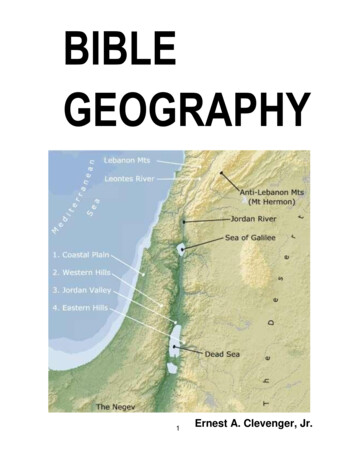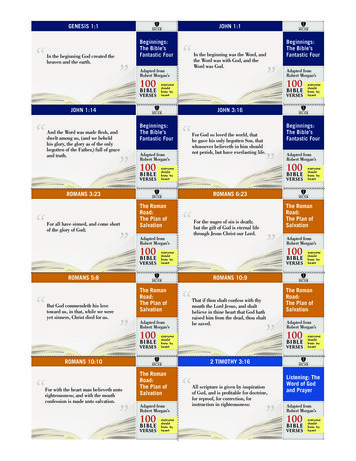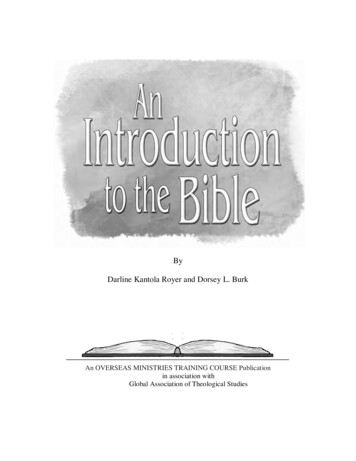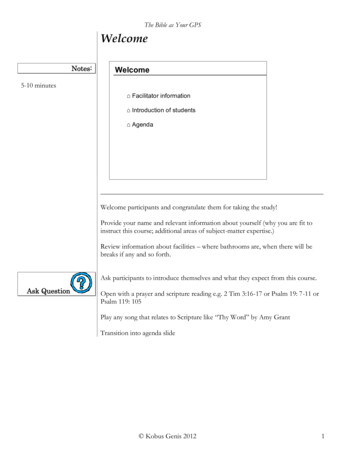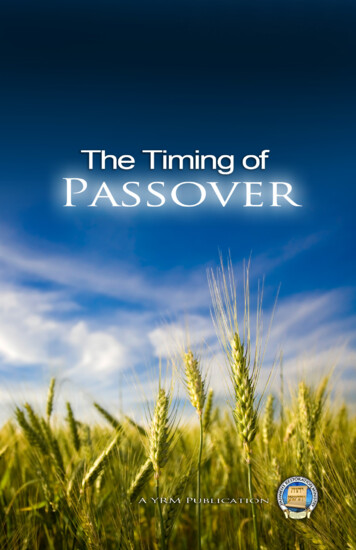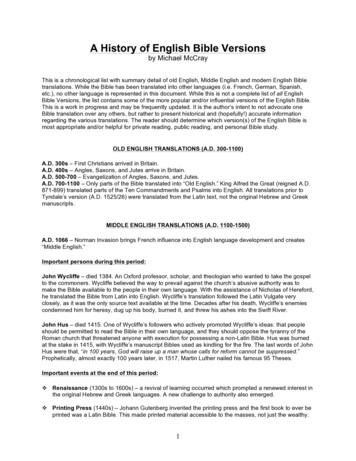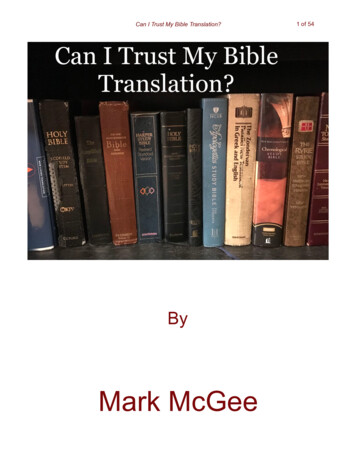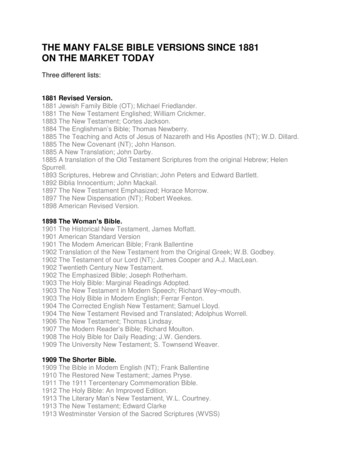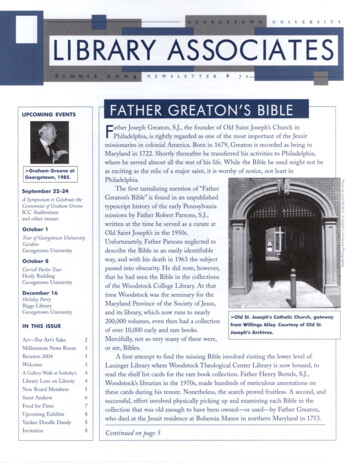
Transcription
NEWSLETTER#FATHER GREATON'S BIBLEUPCOMING EVENTSFGeorgetown, 1985.September 22-24A Symposium to Celebrate theCentennial of Graham GreeneICC Auditoriumand other venuesOctober 1Tour of Georgetown UniversityGardensGeorgetown UniversityOctober 8Carroll Parlor TourHealy BuildingGeorgetown UniversityDecember 16Holiday PartyRiggs LibraryGeorgetown UniversityIN THIS ISSUEArt-For Art's Sake2Millennium News Room3Reunion 20043Welcome3A Gallery Walk at Sotheby's4Library Lens on Liberty4New Board Members5Saint Andrew6Food for Fines7Upcoming Exhibits8Yankee Doodle Dandy8Invitation8ather Joseph Greaton, S.]., the founder of Old Saint Joseph's Church inPhiladelphia, is rightly regarded as one of the most important of the Jesuitmissionaries in colonial America. Born in 1679, Greaton is recorded as being inMaryland in 1722. Shortly thereafter he transferred his activities to Philadelphia,where he served almost all the rest of his life. While the Bible he used might not beas exciting as the relic of a major saint, it is worthy of notice, not least inPhiladelphia.The first tantalizing mention of "FatherGreaton's Bible" is found in an unpublishedtypescript history of the early Pennsylvaniamissions by Father Robert Parsons, S.].,written at the time he served as a curate atOld Saint Joseph's in the 1950s.Unfortunately, Father Parsons neglected todescribe the Bible in an easily identifiableway, and with his death in 1963 the subjectpassed into obscurity. He did note, however,that he had seen the Bible in the collectionsof the Woodstock College Library. At thattime Woodstock was the seminary for theMaryland Province of the Society of Jesus,and its library, which now runs to nearly Old St. Joseph's Catholic Church, gateway200,000 volumes, even then had a collectionfrom Willings Alley. Courtesy of Old St.of over 10,000 early and rare books.Joseph's Archives.Mercifully, not so very many of these were,or are, Bibles.A first attempt to find the missing Bible involved visiting the lower level ofLauinger Library where Woodstock Theological Center Library is now housed, toread the shelf list cards for the rare book collection. Father Henry Bertels, S.].,Woodstock's librarian in the 1970s, made hundreds of meticulous annotations onthese cards during his tenure. Nonetheless, the search proved fruitless. A second, andsuccessful, effort involved physically picking up and examining each Bible in thecollection that was old enough to have been owned-or used-by Father Greaton,who died at the Jesuit residence at Bohemia Manor in northern Maryland in 1753.Continued on page 5
This Newsletter is issued fourtimes a year. It is distributedto all Library Associates,members of ARL, theGeorgetown University Boardof DireL"tors, Board of Regents,Board of Governors, andselected others.UNIVERSITY LIBRARIANArtemis G. KirkEDITORStephanie HughesDESIGN EDITORSusan WalkerARTS EDITORDavid C. AlanCONTRIBUTORSDavid C. AlanMarty BarringerDavid HagenStephanie HughesArtemis G. KirkMaeve O'ConnorChristopher W. PlattsJeffrey PopovichLuLen wn.eduBOOK AND MANUSCRIPTDONATIONSBetty SmithGifts Librarian202. 687.7458smithe3@georgetown.eduART DONATIONSLuLen WalkerArt Collection Curator '202. 687. 1469llW@georgetown.eduMONETARY DONATIONSAND BEQUESTSAurilla FuscoDirector of Development202.687-5666amf49@georgetown.eduGIFTS VIA THE WEBhttp://www.georgetown.edul--. oaurlindex.htmlo Printed on recycled paperSince 1999 the Lauinger Library hasup a gallery in Old North known as themanaged the care and exhibition of the Beauchamp Hughes Art Cabinet. TheUniversity's assortment of fine art,Carroll Parlor became the official venueantiques, furnishings, and other items offor the art collection in 1929, but it cannothistorical significance. Many people havebegin to accommodate the hundreds ofexpressed their delight in learning the oripaintings recorded in the art collectiongins and brief history of the art treasuresdatabase. Most of these works are in vaultof Georgetown.storage today, orBut few peoplehung in prominentknow why thecorridors and officesLibrary hasaround campus."custody of theThe UniversityUniversity's artArt Collection nowcollections.includes more thanA publication400 paintings,written over one12,000 fine arthundred years agoprints, and severalnotes, "Thehundred pieces ofCollege possessesdecorative art,the nucleus of asculpture, antiques,valuable collectionfurnishings, andof works of art, and Conservator Carol Christensen retoucheshistoric Georgetownareas of paint loss on Toscani's Thea number ofmemorabilia includAnnunciation (c. 1425), one of the mostMaryland Colonialing medals, jewelry,important works in the Art Collection. (See therelics. It has longand devotionalstory on The Annunciation in the Fall 2003been the wish ofobjects.A portion ofissue of this Newsletter.)the Faculty tothese treasures is onincrease these collections, and give themdisplay regularly in Carroll Parlor on thethe prominence they deserve." [From Afirst floor of Healy Hall. RotatingCatalogue of the Officers and Students ofselections from the fine prints, broughtGeorgetown College, One Hundred and Third together by the Rev. Joseph A. Haller, S.].,Year, 1890-'91, p. 39.] According toto function as a teaching collection, areLuLen Walker, Art Collection Curator:displayed in the Fairchild Gallery in"In the nineteenth century, paintingsLauinger Library. The Art Collection staffhad been hung in the Healy Building andparticipates in seminars for undergraduateother campus venues but the concept of astudents, and presents special events and'collection' as such did not seem to takelectures to showcase portions of thehold until a benefactor named Louisacollection.Beauchamp Hughes donated her collectionLibraries are excellent stewards ofof art and antiques to the University incollections for posterity. Our track record1899, with enough of an endowment to set in acquiring and organizing materials, andContinued on page 72Library Associates
The second stage of the Library's alumni-funded Millennium News Room projectis complete. The new Media Room, just off the lobby in Lauinger Library, isshowing news, current event and campus programming every weekday. Students andfaculty can also request specific programs.The room includes a plasma screen and a sound system connected to a full complement of audio and video equipment. New carpet, wallcovering and seating createa comfortable environment in which to catch up on the latest news and campusevents.The next step, Phase Three of theMillennium News Room, will create acomfortable reading area for print newspapers in the Pierce Reading Room.Pierce is also off Lauinger's lobby.WELCOMEThe Library welcomesMaeve O'Connor, our newEvents Manager. Maevecomes to us from BostonUniversity, where she wasAssistant Director at theirHuman Resources PolicyInstitute. Originally fromCounty Kerry, Ireland, shehas a Bachelor's degree inGerman and PoliticalScience from UniversityCollege Dublin andMaster's degrees in PoliticalScience and EducationPolicy from UniversityCollege Dublin and BostonUniversity. Art Collection Curator LuLen Walkergave a tour of master works from theArt Collection in Carroll Parlor inHealy Hall. Head of Special Collections MartyBarringer conducted appraisals foralumni in the Gunlocke Room. Hehere offers his expert opinion to PaulAnthony, B'64.Caroline Griswold, ourprevious Events Manager,has not left GeorgetownUniversity. She is now theAssistant Director forDonor Relations and youmay see her at Georgetown events in that newcapacity. Digital Wizardry: Ed Keller andpuppet (r) and Gene D'Andrea (I)demonstrate some of the multimediacapabilities of the Gelardin Center aspart of the Digital Wizardry (Not Justfor Kids!) program.Summer 20043
LIBRARY LENSON LIBERTY Henry Mosler, deta ilfrom The Birth of theFlag, 1912, oil on canvas, 53 1/ 4 x 70 1/ 2".G ift of W. H. Walters,1962.The second in a series ofLibrary-produced videos,L ibrary Lens on Liberty,premiered at the JohnCarroll Awards Weekendin Philadelphia in April.The video highlights a fewof the many print andonline resources, manuscripts, art works and artifacts from the collectionsof the GeorgetownUniversity Library thatsupport the study of liberty.The video can be seenonline tm4ew York area Library Associates took A Gallery Walk and Private Tour of OldMaster Paintings at the venerable Sotheby's auction house in May. Held inSotheby's magnificently renovated building on York Avenue, the event included a saleof donated items conducted by aSotheby's auctioneer and anopportunity for Associates to see therecently identified "thirty-sixthVermeer," sold at auction July 7 atSotheby's in London for a record 30,006,650.Assistant Vice President for OldMaster Paintings Clarissa Post, C'97,who worked in Lauinger Library'sPicchi Multimedia Center during herundergraduate years, led the tour of theOld Master Paintings in Sotheby's newtenth-floor exhibition gallery. She Turning the panel over, Sotheby's Assistant VicePresident for Old Master Paintings, Clarissa Postexplained for her audience how selectC'97, shows Library Associates how an early seven paintings acquired their historicalteenth-century Flemish painting slated for upcomimportance and value for the art maring auction has survived in very good condition .ket, and in a fitting finale, described thecomplex and rigorous investigative process that led scholars to conclude that YoungWoman Seated at the Virginals (c. 1670) deserved inclusion in the rare oeuvre of theNetherlandish master Johannes Vermeer.According to Georgetown art collection staff who attended the event, threeartists found in the Georgetown University Art Collection-Roelant Saverij, PeterLely, and David Teniers the Younger-were represented in the Sotheby's paintingsshown on the tour.Following the gallery walk, the assembly convened in Sotheby's board room foran auction of items donated by friends of the Library, including letters written byUnion soldiers in 1862, rare books and coins,jewelry, and donated holidays and dinners.Under the accomplished hand of Sotheby'sauctioneer Brad Benthoff, the sale realized animpressive sum to benefit the Library. TheLibrary Associates are grateful to Mr.Benthoff and to the winning bidders for theirgenerosity.The Library would especially like tothank William Sheridan, Sotheby's CFO and From left to right: Sotheby CFOGeorgetown parent (P'04, P'07), for hisWilliam Sheridan P' 04, '07; Artemis G.generosity in making possible and sponsoringKirk; John Forsgren C'67, David Walshthe event.C'58, and E. Anthony Kerbs C'73.NLibrary Associates
r e Georgetown University Library Board elected three new members at its spring meeting in April.Angela Dinger C'93, L'98, is general counsel for the publishing company William H. Sadlier, Inc, afamily-owned publisher of educational materials since 1832.Dr. Henry I. A. Nowik is a former member of the Library's Board and a long-time friend of the Library.He is recently retired from his professorship at Georgetown's School of Foreign Service.James Michael Wilson B'74, a long-time supporter of the Library, is with Mozart DevelopmentCompany, a San Francisco-area real estate developer and management company.FATHER GREATON, continuedSure enough, one of the first items checked was a two-volume first edition set of the Catholic Old Testamentin English, published in Douai in what is now northern France in 1609-10. Both volumes were rebound in thenineteenth century by an indifferently talented craftsman; both revealed considerable and lamentable flaws inthe paper of their text blocks. But in the second volume-had it been in the first Father Bertels would certainlyhave found it-was a pasted-in note reading:ResidentitR BaltimorensiEx domo [probably a misspelling of "dono"]Rdi. P. Jos: GreatonAnno Dfzi 1752ResidentitR Sti Josephiin BaltimoreA search turned up no companion New Testament, hardly surprising given the rarity of editions of theCatholic Bible, or even any part of it, in colonial America. The first Catholic Bible to be printed in Americawould not appear until 1790.The route Father Greaton's Bible took to Woodstock is circuitous, and not entirely known. Consideredredundant in Baltimore, it was given in 1853 by Father Timothy O'Brien to the then-Jesuit editor, collector,and bibliographer Father Joseph Maria Finotti, who duly recorded the gift in the book itself But Father Finottidied in 1879 in Colorado, leaving a voluminous library of American Catholic rarities, the basis for hisBibliographica Catholica Americana, published in 1872; his literary executor was the noted Catholic historianJohn Gilmary Shea. Shea picked out from Finotti's books those he wanted; the rest he consigned to a series ofauctions. We know he didn't pick out this admittedly somewhat tattered copy of the Douai Bible, becauseShea's library passed intact to Georgetown University following his death in 1892. The Woodstock stamps inthe two volumes of the Bible are early, and it's just possible that the books were purchased at the Finotti sales;certainly they entered the Woodstock collection not long after that time.Summer 20045
The Art Collection's impressive Martyrdom of Saint Andrew (ca. 1653) is attributed to Genoese painterI Domenico Fiasella (1589-1669), a leading exponent of the seventeenth-century Genoese School of painting.According to some accounts, seven decades after Jesus was crucified, his apostle Andrew underwent the samepunishment. To disparage and mock his Christianity, the Romans tilted the cross on which he was crucified sothat it appeared as an "X" rather than in the shape held in reverence by the Christian faithful. Andrew had converted multitudes to Christianity throughout the Mediterranean, including the wife of a Roman provincial governor in southern Greece; the governor, in turn, immediately ordered Andrew to be scourged and then crucified.In the center of the painting, Andrew is shown on his knees in a prayerful pose. A sense of dramaticinstability, characteristic of many Italian Baroque paintings, imbues the diagonal composition. Groups of figuresand a series of hills lead the eye to the final hill in the upper right, where the cross stands awaiting Andrew'simpending martyrdom. On the hill in the upper left-center of the canvas, two trees cross to form an "X," reflecting the shape of the cross on the opposite side of the painting. The leaves sprouting from the branches of thesetrees suggest life, in contrast to the cruciform treetrunks presaging Andrew's imminent death. Apartially obscured man in the lower left corner ofthe canvas stares at the viewer, inviting us into thescene as part of the audience that encirclesAndrew.Most of Fiasella's works depict religious subjects, as well as mythological scenes and portraits.Fiasella was influenced by a 1607 trip to Rome, tosee and copy works by Caravaggio, Guido Reni,Guercino, and other masters, and to visit thesculptural and architectural monuments ofclassical antiquity. He was also influenced byFlemish masters Peter Paul Rubens and AnthonyVan Dyck, both of whom visited Genoa.! WhenFiasella returned to Genoa in 1616, he received patronage from the Genoese nobility and later founded a schoolto train young painters.Unfortunately, no records survive detailing the provenance of Georgetown's Martyrdom of Saint Andrew. Afterextensive research, Art Collection Curator LuLen Walker attributed the work to Domenico Fiasella based on itsstylistic similarities to his other works (including another version of The Martyrdom of Saint Andrew), such as hisuse of color and figure forms. The religious subject matter is compatible with other important Italian Baroquepaintings in the Georgetown University Art Collection, such as Luca Giordano's The Calling of St. Matthew, anddepictions of St. Sebastian and St. Jerome that are currently in the Vault awaiting conservation.Roughly three feet tall by four feet wide, the painting is in good condition considering its manufacture morethan 350 years ago. Craquelure (a networks of cracks), and loose, flaking paint, are evident in a several places inthe upper-center and upper-left areas of the canvas. Recently the painting was removed from an administrative!A later work by Van Dyck, Portrait ofj ean-Baptiste j anssens van Bisthoven (1630), can be seen in Carroll Parlor.Continued on back page6Library Associates
making them accessible for the public good, is second to none. The conservationof art is as natural to libraries as the preservation of books, because all these itemsrepresent unique knowledge, from which new knowledge will spring. Weconserve culture in order to create culture.Libraries instruct and inform future scholars. Our research mission isenhanced by the availability of primary source materials, whether they are inprint, digital, or physical format. We receive gifts that may serendipitously turninto new collections because donors trust libraries to care for items they themselves can no longer sustain, but find it unthinkable to discard. Sometimes theact of receiving letters and manuscripts from an expected collection yields surprises. The Loughborough Family Papers, for example, came to us in a woodenchest dating from the Civil War period and containing a worn but originalConfederate battle flag. As Professor Paul Betz has noted, "What else iscollecting but the rescue of artifacts from the vanishing past?"In much the same way as a book and journal collection would be crafted andmanaged to support a teaching discipline, Georgetown University's Library hasadministered and cared for the rich collections that have now surpassed the 1891assessment as a "nucleus of a valuable collection of art." Our personnel have overlapping expertise for related collections. The proximity of archivists to documentthe provenance for paintings, reference librarians to assist in research, and artspecialists to assist scholars and students in their academic pursuits, means thatstaff share their knowledge collaboratively for the benefit of the work theyperform individually.As with print and digital library collections, the art collections need adequatespace for safekeeping, venues for display, staff for teaching and researching, andfunds for conservation, preservation, and future acquisition. We are grateful forthe good people of Georgetown's past who have acquired, preserved, displayedand cared for this remarkable art collection. And we are both honored and havethe collective knowledge to be its present curators, for the sake of the art tothrive in the future.Lauinger and Blommer Science Library held their annual Food for Fines drivein April. Patrons were able to donate non-perishable food in exchange forhaving up to 20 of their fines waived. Each item donated waived one dollar infines, and 900 items of food were collected this year.GEORGETOWN LEGACYSOCIETYThe Georgetown LegacySociety was established torecognize alumni and friendswho have included a gift forGeorgetown in their estateplans. These gifts take manyforms, including simplebequests by will, gift annuities, and charitable trusts.Many of these plans offersubstantial financial and taxsaving benefits, often complementing an individual'soverall estate plans. All aregreatly appreciated and helpto ensure the tradition ofexcellence at Georgetown forfuture generations.We would be honored toinclude you as a member ofthe Legacy Society. If youhave included the LauingerLibrary in your estate plans,please let us know. For moreinformation about the LegacySociety, please contact theOffice of Planned Giving at800.347.8067 or 202 .687-3697Visit our web site atwww.georgetown.eduloaur andclick on Gift and Estate Planning.Food is donated to Breadfor the City, a private, non-profit organization thatprovides vulnerable residents of Washington, DC with comprehensive servicesincluding food, clothing, medical care, legal and social services in an atmosphereof dignity, respect and peace. More information on Breadfor the City is availableat www.breadforthecity.org.Summer 20047
UPCOMING EXHIBITSMay - SeptemberYankee Doodle Dandy: A Celebration of George M . Cohan wason view in the Stephen Richard Kerbs (C'67) Exhibit Areaduring the week preceding Independence Day.The exhibit featured the Art Collection's latestacquisition, the Portrait of George M. Cohan by EugeneH iggins; and several photographs from Cohan's life,including one signed by the famed composer.Histories and Tragedies fromthe Boydell Shakespeare FolioFairchild GallerySeptember - December20 Years of Prints for theWashington Print Club's40th AnniversaryFairchild GalleryINVITATIONMay - SeptemberG oing for G old: Georgetownand the Paris Olympics, 1900K erbs Exhibit Area Eugene Higgins (1874-1958)Portrait of George M. Cohan, ca.1915, pastel on paper, 47.5 x 37em.SeptemberAfter the Qyake: Stories byH aruki MurakamiK erbs Exhibit A rea20 Years of Prints for the Washington PrintClub's 40th Anniversary will be on view fromSeptember 1 through November 23 in theFairchild Gallery. A reception will be held onSaturday, September 18 from 4:00 to 6:00 p.m.The public is invited, and the admission is free.Please reply to artcollection@georgetown.edu,or call (202) 687-4484, if you plan to attend.May - SeptemberFamous FiddlersLeon R obbin Gallery--- -. --- . .---.affer thequake.office where it was hung, to prevent further deterioration. The surface paint layer hasbeen abraded in several places in the bottom half of the work to reveal a thin underlayerthrough which the weave of the canvas can be seen. Brown and black spots of dirtdapple the entire surface, darkening the composition and obscuring the bright colorswith which Fiasella likely painted. The entire work needs to be cleaned, the canvasrestretched, and several areas retouched- after which it will more closely demonstratethe original work of the artist.Georgetown UniversityL ibrary Associates3700 0 Street, N WWashington, D C 20057-1006D
describe the Bible in an easily identifiable way, and with his death in 1963 the subject passed into obscurity. He did note, however, that he had seen the Bible in the collections of the Woodstock College Library. At that time Woodstock was the seminary for the Maryland Province of the Society of Jesus, and its library, which now runs to nearly
